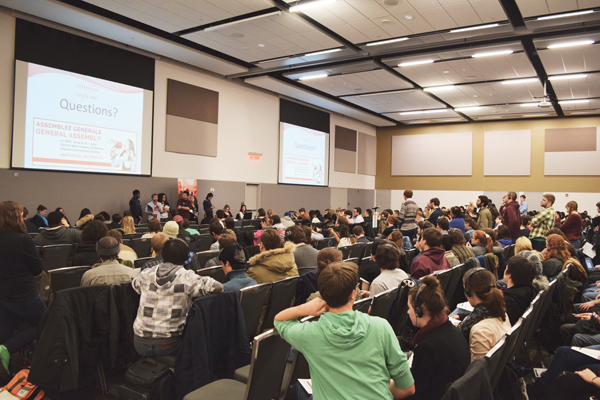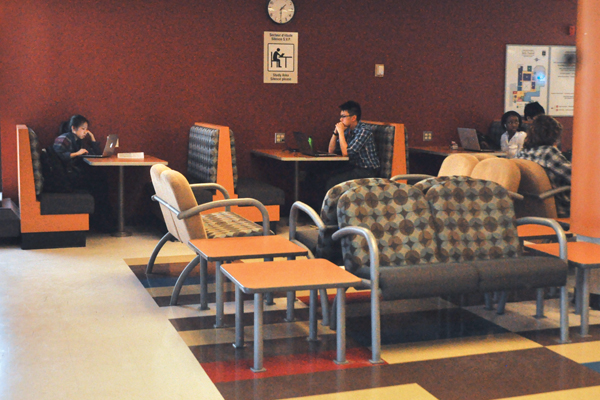Survey of Ontario universities finds three in five U of O students reported experiencing sexual harassment in 2017-18 year
Content warning: Sexual violence
The province’s Ministry of Colleges and Universities published the results of their Student Voices on Sexual Violence survey late last month, which is designed to highlight and address sexual violence on Ontario post-secondary campuses.
All full-time undergraduate and graduate students were invited to participate in the survey, which was conducted between February and April 2018 by CGI Research. A total of 117,148 university students completed the survey, a response rate of 26.5 per cent.
The survey measured the prevalence rates of sexual assault, sexual harassment, and stalking on campuses since the start of the 2017-18 academic year to the time students responded to the survey. At the U of O, prevalence rates were below or in line with averages across Ontario universities.
More than 80 per cent of respondents to the survey indicated they were enrolled in undergraduate programs, while only 10 per cent were masters students and five per cent in their doctoral programs.
The majority of respondents were women, with 69 per cent of respondents identifying as female. Twenty-nine per cent of the response group identified as male, while two per cent identified as transgender, Two-Spirit, non-binary or gender fluid.
The Council of Ontario Universities urged caution when comparing the survey results between schools, as demographic profiles of both campus populations and respondents may vary.
One in five U of O students report being sexually assaulted since start of 2017-18 academic year, survey finds
The survey asked about various types of sexual assault behaviours, including being fondled or kissed, attempted oral/penetrative sex, and oral/penetrative sex. Overall, 23 per cent of Ontario university students — and 22 per cent of University of Ottawa students — responding to the survey said that they experienced sexual assault since the start of the 2017-18 academic year.
Students were also asked whether their unwanted sexual experiences were the result of coercion. At nearly 60 per cent, the most common response was that someone was caught off guard or their body language and non-verbal signals were ignored, followed by someone being taken advantage of when they were drunk, had taken drugs, was asleep or was unconscious at 41.6 per cent.
When asked to describe the perpetrator, the most common categories selected were “another student” at 49.5 per cent, or “someone with no affiliations to university” at 46 per cent. At 87 per cent, the majority of respondents indicated that the perpetrators’ gender identity was male .
The survey also found that 50 per cent of sexual assault incidents happened before and within the first six weeks of classes.
Three in five U of O students report experiencing sexual harassment since start of 2017-18 academic year, survey finds
Overall, 63.2 per cent of Ontario university students in the survey indicated they experienced sexual harassment at least once since the start of the 2017-18 academic year. At the U of O, the survey found that the rate of sexual harassment prevalence was 62.4 per cent.
Nearly 24 per cent of students at the U of O stated that they had been stalked at least once since the beginning of the 2017-18 academic year. Across the province, the average number was 23.7 per cent.
LGBTQ2S+ communities, students with disabilities emerge as vulnerable groups, survey finds
According to the survey, rates of sexual assault, harassment and stalking vary across key demographic factors such as gender identity, sexual orientation and age.
Prevalence rates of sexual assault, sexual harassment and stalking for women and gender diverse survey respondents are higher overall. Similarly, prevalence rates among bisexual, gay, lesbian, or other sexually diverse identities are higher than the overall rate for all three forms of sexual violence.
Students who identified as having a disability also had prevalence rates higher than the overall university sector rates. Students who were under 25 had higher prevalence rates than those over 35 for sexual assault, sexual harassment and stalking.
Just below half of respondents across province reported disclosing sexual violence incident
More than 46 per cent of respondents indicated that they disclosed their sexual violence incident, while 35.6 per cent did not tell someone, and 17.8 per cent selected “not sure.” The decision to disclose varied across demographic groups such as gender and racial and ethnic identity.
Of those who disclosed experiencing sexual violence, 97.8 per cent reported telling a friend, family member, or roommate, while 9.4 per cent told an institutional representative such as a university staff member or therapist.
For those who did not tell someone, the five most commonly selected reasons were “not thinking it was serious enough” at 50.7 per cent. “Not needing any help” was the second most common response at 32.3 per cent, followed by “did not want any action taken” at 24.8 per cent.
More than 26 per cent of respondents “believed it would cause more trouble than it was worth”, where 15 per cent were “too embarrassed” to report the incident. Students holding the belief that their experiences are not serious enough are also some of the most at risk for sexual violence, such as women, gender diverse, or younger people.
Across post-secondary campuses, less than half of respondents — 43.1 per cent — understood how to access supports (counselling, health services, housing, safety and security related to sexual violence. Only 12.2 per cent know how to file a formal report regarding an incident of sexual violence at their university.
At the U of O, just under 20 per cent of respondents said they understood or knew how or where to access supports or find information related to reporting incidents of sexual violence on campus, the lowest in Ontario. Provincially, that number was 22.4 per cent.
What is the U of O doing?
At a mental health town hall hosted late last month, one student highlighted the need for the university to better address sexual violence on campus and acknowledge the intersection of sexual violence and mental health, highlighting data from the survey.
“I hope that these numbers do not shock you, (U of O president Jacques) Frémont — this is publicly available data on your university,” said the student. “If it is surprising to you, that is because you have chosen to ignore the voices of young women on this campus.”
The student shared concerns with the triage appointment system available to students who experience sexual violence through the Student Academic Success Service (SASS).
“A triage appointment is structured in a way where a student must essentially sell themselves on why they need care, on why they’re worthy of support from SASS,” the student said. “Your triage system forces survivors to disclose, which is against best practices when it comes to sexual violence counselling.”
The student said those who experience sexual violence often end up being referred by SASS to off-campus resources, such as the Ottawa Rape Crisis Centre, but many of those types of centres say they’re in need of more provincial funding.
“President Frémont, I implore you to show that you care about women on this campus and take action on sexual violence prevention and postvention by hiring a counsellor at SASS who specializes in sexual violence,” the student said.
In a Gazette article posted shortly after the survey results were published, the administration said its standing committee on the prevention of sexual violence will review the findings and evaluate the initiatives and programs it has put in place since 2018. The administration said it will also evaluate what new programs and initiatives should be developed.
“These reports help establish an important baseline measurement for the student experience in this province and at the U of O in 2018,” Noël Badiou, director of the school’s Human Rights Office, said in the Gazette article. “They reinforce the importance of our work in the prevention of sexual violence and the need to continue existing initiatives and pursue new ones to help keep our students safe.”
Badiou is chair of the standing committee, made up of students, faculty, staff and community members. Back in 2017, a sexual violence prevention officer was hired to help support the committee’s mandate, and the position was made permanent last year.
“I believe that the university is fully committed to continue supporting efforts in prevention and addressing sexual violence when it does occur,” said Badiou. “I know that our efforts are having a positive impact in terms of awareness and we have a team who believes as much as I do that everyone deserves a respectful, supportive and safe learning, working and living environment.”
A non-comprehensive list of sexual violence resources appears below…
- The Ottawa Rape Crisis Centre: Crisis Line (24/7) 613-562-2333, office line 613-562-2334
- Sexual Assault Support Centre of Ottawa: Support Line (24/7) 613-234-2266, office line 613-725-2160
- Minwaashin Lodge – Aboriginal Women’s Support Centre: Crisis line 613-789-1141, office line 613-741-5590
- CALACS: Fem’aide 1-877-336-2433, office Line 613-789-8096
- Men & Healing: 613-482-9363
- Immigrant Women’s Services Ottawa: Office line 613-729-3145
- Ottawa Victim Services: 613-238-2762
- Wabano Centre for Aboriginal Health: 613-748-5999
- Catholic Family Services: 613-233-8478
- Sexual Assault and Partner Abuse Care Program: 613-798-5555 x13770






